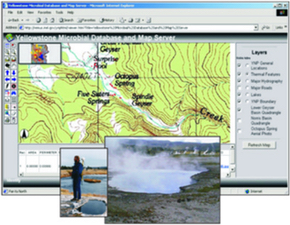What is geospatial science?
Geospatial science is a discipline that focuses on using geographic information technology to better understand physical, social, and economic processes through spatial data analyses and various forms of visualization. Technologies at the forefront of geospatial science include geographic information systems (GIS), the global positioning system (GPS), and remote sensing. These technologies have penetrated nearly every aspect of our lives including vehicle navigation, route planning, and the management and maintenance of city infrastructure, regional agriculture, and natural resources.
How we support INL
The Geospatial Science and Engineering group at Idaho National Laboratory leverages cross-cutting capabilities in Geographic Information Science (GIScience), remote sensing, database development and management, 3D visualization, GPS, software development, and web development, to provide products that support decision-makers in a variety of applications.
We hold degrees in GIScience, geology, hydrogeology, engineering, and environmental science. We are responsible for the development of iMap and the various specialty versions of iMap, management of Archibus and WebCentral, maintenance of the Facility Information System and all hardcopy map products. When you think of mapping, whether it's terrain, facilities, structures, earth features, or any other data that needs to be spatially displayed for analysis and planning, we can help.
What we do
The Geospatial Science and Engineering team at Idaho National Laboratory (INL) leverages cross-cutting capabilities in Geographic Information Science (GIScience), remote sensing, database development and management, 3D visualization, GPS, software development, and web development, to provide products that support management in decision-making, and help employees in their day-to-day activities.
We hold degrees in GIScience, geology, hydrogeology, engineering, and environmental science. We develop various tools for facility management at the laboratory enabling them to access a wide-variety of detailed information about facilities and space usage, to plan for incoming projects and space needs. Our web-based map applications enable employees to located buildings, conference rooms, and other resources they need. And we develop specialized tools that provide advanced mapping and planning capabilities for the Emergency Services organization at the laboratory, enabling them to be better respond to any emergency situation that may arise.
With a diverse and varied background and experience base, we are able to provide unique solutions to a variety of problems.





















